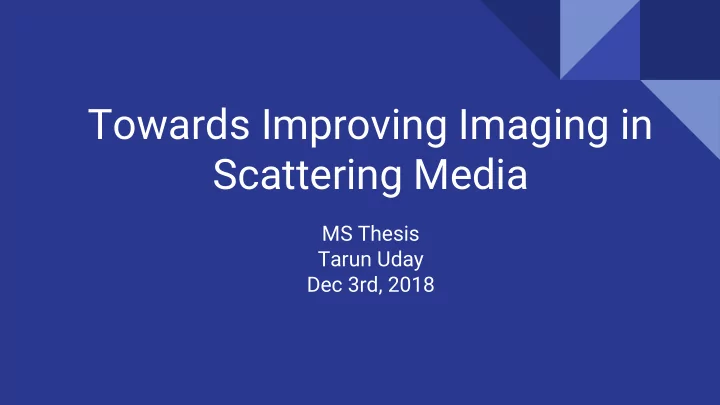

Towards Improving Imaging in Scattering Media MS Thesis Tarun Uday Dec 3rd, 2018
Towards Improving Imaging in Scattering Media 1. Underwater imaging and photomosaicking 2. Issues faced in large-area photomosaicking 3. Understanding optical properties of ocean water 4. Current mitigation techniques 5. Proposed solution 6. Design of Experiments 7. Data collection and Analysis 8. Results 9. Conclusions
Underwater imaging and photomosaicking ● Large areas of interest - high field of view with high resolution cameras Images collected with sufficient overlap along with platform motion data ● helps stitch images together (photomosaicking) Photomosaicking without errors necessitates high contrast features on the ● individual images
Low contrast / featureless images are hard to build photomosaics on and possible errors creep in. Increasing contrast fixes duplication of features in low contrast images [Singh et al., 2004]
Issues faced in large-area photomosaicking 1. Covering large areas of interest require large field of view Image quality is limited by the energy received by camera [1] , proportional to 2. distance to target 3. Backscatter, proportional to volume of water between platform and target, reduces contrast Singh [2004] 4m away 8m away
Understanding optical properties of ocean water Inherent properties : Independent of light energy and dependent only on properties of medium 1. Absorption: Conversion of incident light energy to other forms 2. Scattering: Change in direction and/or energy. Forward scatter - scatter direction <10 o Backscatter - scatter direction >170 o 3. Attenuation: Total intensity loss Sum of Absorption and Scattering effects Measure of translucency, turbidity
Understanding optical properties of ocean water Scatter effects on image quality 1. Reduction in sharpness (blurring) due to forward scatter component 2. Reduction in contrast due to backscatter component
Current mitigation techniques ● Source - Receiver Separation [limited by design of platform] Polarization [limited by reduced light intensity] ● Range Gating [limited by complexity and cost] ● ● Synchronous Laser Scan [limited by time taken and cost] Source - Receiver separation reduces the common scatter volume
Proposed solution Reduce the light from the current ‘floodlight’ setup to a narrow stripe for smaller common scatter volume Sweep this stripe over the target area, building a composite image Tradeoff: time taken to sweep area for better image quality Attempted by other researchers [2][3] for ranges of < 1m
M Levoy, H Singh [2009] 5 x 1200 lumens projector
G Gorman [2011] 50 Lumens projector
Design of Experiments ● Tank with largest dimension 3m 6000 lumens Optoma projector for ● high intensity light ● Sony Alpha 7 iii Camera for high dynamic range in low light Food grade Zinc Oxide for ● increasing scatter effects ● Scattering meter to measure volume scatter coefficient ISO 12233 Resolution Test Chart ●
Design of Experiments ISO 12233 Photography Lens Test Resolution Chart
Design of Experiments ● 6 datasets of increasing scatter / turbidity Each dataset has floodlight images and ● stripe light images ● Stripe light composite image built by taking pixelwise maximums over images ● ● Sharpness Metric = Variance of Laplacian of illuminated area
Data Collection and Analysis Dataset 1 Scattering coefficient: 0.0116 m -1 sr -1 Illumination Type Sharpness Metric Contrast Metric Floodlight 24.74 0.423 Stripe with n = 20 92.49 0.803
Data Collection and Analysis Dataset 2 Scattering coefficient: 0.0193 m -1 sr -1 Illumination Type Sharpness Metric Contrast Metric Floodlight 15.37 0.348 Stripe with n = 6 27.30 0.634 Stripe with n = 12 39.22 0.563 Stripe with n = 20 64.70 0.745
Scattering coefficient: 0.0257 m -1 sr -1 Dataset 3 Data Collection and Analysis Illumination Type Sharpness Metric Contrast Metric Floodlight 12.39 0.299 Stripe with n = 10 16.58 0.488 Stripe with n = 20 18.79 0.572 Stripe with n = 40 26.23 0.681
Scattering coefficient: 0.0305 m -1 sr -1 Dataset 4 Data Collection and Analysis Illumination Type Sharpness Metric Contrast Metric Floodlight 13.51 0.286 Stripe with n = 10 19.24 0.462 Stripe with n = 20 22.51 0.540
Scattering coefficient: 0.0344 m -1 sr -1 Dataset 5 Data Collection and Analysis Illumination Type Sharpness Metric Contrast Metric Floodlight 12.88 0.104 Stripe with n = 10 15.45 0.214 Stripe with n = 20 16.35 0.237 Stripe with n = 40 18.61 0.293
Dataset 6 Scattering coefficient: 0.0371 m -1 sr -1 Data Collection and Analysis Illumination Type Sharpness Metric Contrast Metric Floodlight 13.71 0.0265 Stripe with n = 20 17.23 0.0305
Results As scatter increases, there is a clear deterioration of the image quality
Results
Results
Results For the same scatter values, if illumination per image captured reduces, there is a marked increase in the image quality Floodlight (n=1) n=10 n=20 n=40
Results
Results
Conclusions This is a system that can be implemented Smaller stripe significantly reduce scatter effects Downsides - Halving the strip size implies: Twice the time to sweep * almost twice the time for exposure to attain same level of brightness
Future Work ● Build waterproof system and do a field test Better image composition ●
References [1] Singh, H., Howland, J., and Pizarro, O., (2004). “Advances in Large-Area Photomosaicking Underwater,” IEEE Journal of Oceanic Engineering, 29(3), 872-886 [2] Gupta, M., Narasimhan, S. G. and Schechner, Y. Y., (2008). “On Controlling Light Transport in Poor Visibility Environments,” In ACM SIGGRAPAPH ASIA 2008 courses, Article 68 [3] Gorman, G., “Field deployable dynamic lighting system for turbid water imaging,” Master’s thesis, MIT/WHOI Joint Program in Oceanography / Applied Oceans Science and Engineering, 2011.
Acknowledgements
Recommend
More recommend